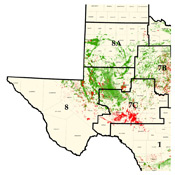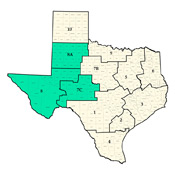Permian Basin Information

Map of active oil wells (green dots) and gas wells (red dots) in the Permian Basin.

Texas Counties in the Permian Basin. Click on map to view higher resolution image.
General Information | Statistics | Counties Affected | Tell Us What You Think | Jurisdiction Information | Water Issues | FAQs
The Permian Basin is an oil-and-gas-producing area located in West Texas and the adjoining area of southeastern New Mexico. The Permian Basin covers an area approximately 250 miles wide and 300 miles long. Various producing formations such as the Yates, San Andres, Clear Fork, Spraberry, Wolfcamp, Yeso, Bone Spring, Avalon, Canyon, Morrow, Devonian, and Ellenberger are all part of the Permian Basin, with oil and natural gas production ranging from depths from a few hundred feet to five miles below the surface. The Permian Basin remains a significant oil-producing area, producing more than 270 million barrels of oil in 2010 and more than 280 million barrels in 2011. The Permian Basin has produced over 29 billion barrels of oil and 75 trillion cubic feet of gas and it is estimated by industry experts to contain recoverable oil and natural gas resources exceeding what has been produced over the last 90 years. Recent increased use of enhanced-recovery practices in the Permian Basin has produced a substantial impact on U.S. oil production.
The Permian Basin is composed of more than 7,000 Railroad Commission (RRC) fields, and is best represented in RRC production figures as RRC districts 7C, 08, and 8A, covering 59 counties in West Texas (see list below). However, the majority of the current development in the Permian Basin may be attributed to certain specific fields. Please see the graphs in the section below for rankings and production/well counts for the top largest fields in the Permian Basin.
Drilling Permits Issued
Crude Oil Production
Total Natural Gas Production
Condensate Production
| Year | Drilling Permits Issued |
|---|---|
| 2005 | 4,435 |
| 2006 | 4,737 |
| 2007 | 4,703 |
| 2008 | 6,178 |
| 2009 | 3,323 |
| 2010 | 6,830 |
| 2011 | 9,235 |
| 2012 | 9,335 |
(Permit data obtained from RRC W-1 query on 03/27/2013.)
Please see graph below for additional information
Historical drilling permits| Year | Oil Produced (million barrels) |
|---|---|
| 2005 | 253 |
| 2006 | 252 |
| 2007 | 251 |
| 2008 | 260 |
| 2009 | 260 |
| 2010 | 270 |
| 2011 | 295 |
| 2012 | 312 |
(Production data obtained from RRC Production Data Query on 03/27/2013.)
Please see graph below for additional information
Top Permian Basin Operators
Total production by year
Oil production by year
Casinghead gas production by year
Condensate production by year
Gas well gas production by year
(Data for each graph obtained from RRC Production Data Query on 03/27/2013.)
Top Permian Basin Fields:
Top 10 highest producing fields (part 1 of 2)
Top 10 highest producing fields (part 2 of 2)
Top 50 highest injection/disposal well counts
Top 50 highest oil well counts
Top 50 highest producing fields (cumulative historical total)
Top 50 highest producing fields (1993–2012)
(Well count and historical field data obtained from RRC proration schedule on 03/01/2013. Field production data obtained from RRC Production Data Query on 03/27/2013.)
Total cumulative oil production (1921 to present):
28,478,229,290 (approximately 29 billion barrels)
For calendar year 2012 (the most recent total production year available),the Texas Permian Basin’s crude oil production accounts for 57 percent of Texas’ statewide total crude oil production or approximately 430 million barrels. For all Texas liquid production including crude oil and condensate (condensate is the liquid hydrocarbons produced with natural gas including butane, propane, etc.), the Permian Basin represents 51 percent of the total statewide Texas liquid production or approximately 509 million barrels of crude oil plus condensate), per current Commission production reports. The Permian Basin accounts for 14 percent of the total annual U.S. oil production or approximately 2 billion barrels according to data obtained from the U.S. Energy Information Administration . Statewide, Texas’ annual crude oil production represents about 25 percent of the total U.S. oil production.
Wells carried on the RRC proration schedule:
Currently 133,000 total wells are carried on the proration schedule in the Permian Basin, 22,000 of which are listed as active injection/disposal wells and 82,000 of which are listed as active producing wells. The RRC proration schedule is a list of oil and gas wells on schedule to produce and submit monthly production reports to the Commission.
| Year | Rig Count |
|---|---|
| 2005 | 129 |
| 2006 | 158 |
| 2007 | 191 |
| 2008 | 218 |
| 2009 | 103 |
| 2010 | 237 |
| 2011 | 355 |
| 2012 | 415 |
(Data obtained from Baker Hughes Rig Count on 03/27/2013.)
In 2010 there were approximately 47,000 Oil & Gas related employees associated with activities in the Permian Basin according to data obtained from the Texas Workforce Commission.
Permian Basin Counties
| ANDREWS | HOCKLEY | NOLAN |
| BORDEN | HOWARD | PECOS |
| COCHRAN | IRION | REAGAN |
| COKE | JEFF DAVIS | REEVES |
| CRANE | KENT | SCURRY |
| CROSBY | KIMBLE | STERLING |
| DAWSON | LAMB | TERRY |
| DICKENS | LOVING | TOM GREEN |
| ECTOR | LUBBOCK | UPTON |
| GAINES | LYNN | WARD |
| GARZA | MARTIN | WINKLER |
| GLASSCOCK | MIDLAND | YOAKUM |
| HALE | MITCHELL |
What does the Railroad Commission have jurisdiction over and whom to contact?
The Railroad Commission regulates the exploration and production of oil and natural gas in Texas. The Commission’s primary responsibilities include: preventing waste of oil and gas resources; protection of surface and subsurface water; and, ensuring all mineral interest owners have an opportunity to develop their fair share of the minerals underlying their property.
The RRC has provided an information page containing links to city, county, state, and federal governments within the Permian Basin area.
For further information, please contact our district offices.
What does the Railroad Commission NOT have jurisdiction over and whom to contact?
The Railroad Commission does not have jurisdiction over roads, traffic, noise, odors, leases, pipeline easements, or royalty payments.
Roads and Traffic: The Railroad Commission does not have jurisdiction over, and exercises no regulatory authority with respect to, private or public roads or road use. Permits issued by the Commission for oil and gas exploration, production, and waste disposal do not limit any independent authority of a municipality, county or other state agencies with respect to road use.
The Texas Department of Transportation (TXDOT) oversees the construction and maintenance of state highways within their jurisdiction. In addition, TXDOT is responsible for issuing access permits to well sites from a roadway on the state highway system. Please review letter for specific access permit requirements. To contact the appropriate district office, please visit the Texas Department of Transportation, Local Information web site. For county or city contact information, please visit the Texas Association of Counties.
Noise: The Commission has no statutory authority over noise or nuisance related issues. Noise and nuisance related issues are governed by local ordinances.
Odors and Air Contaminants: The Railroad Commission does not have regulatory authority over odors or air contaminants. However, for a well within the city limits, the city may enact ordinances regarding odors or other nuisances. In addition, the Texas Commission on Environmental Quality (TCEQ) has jurisdiction over odor and air contaminants. Please see http://www.tceq.state.tx.us/compliance/complaints/odor_complaint.html.
Oil and Gas Exploration and Surface Ownership: For general information pertaining to exploration and surface ownership, please visit the Oil and Gas Exploration and Surface Ownership web page.
Royalty payments: For general information pertaining to leases and royalties, please visit the General Information Pertaining to Leases and Royalties web page.
Top Questions Asked about the Permian Basin
Please contact us with comments and suggestions concerning the Permian Basin Information web area.
Last Updated: 11/26/2014 11:35:46 AM


